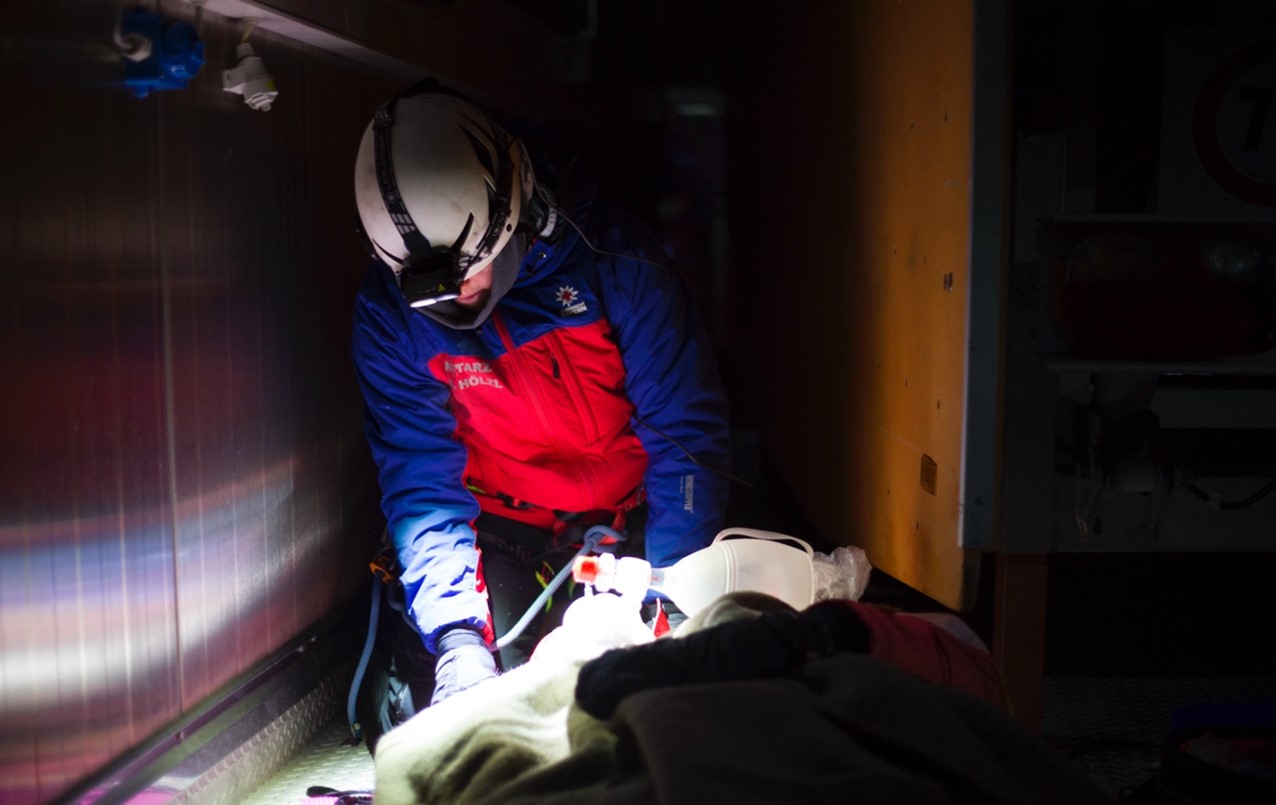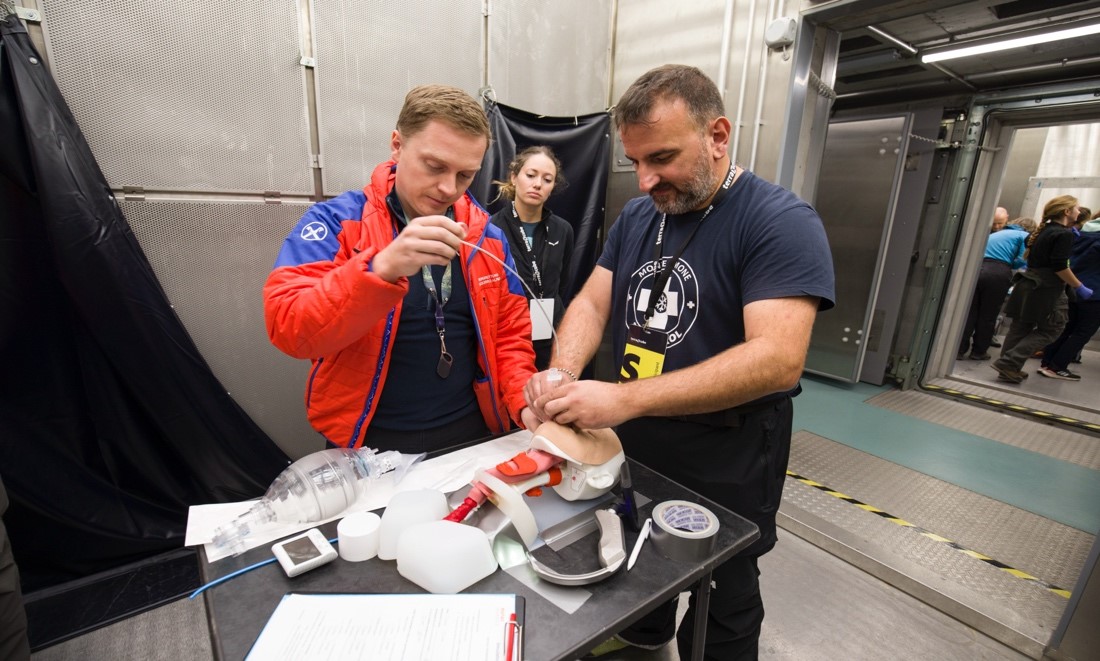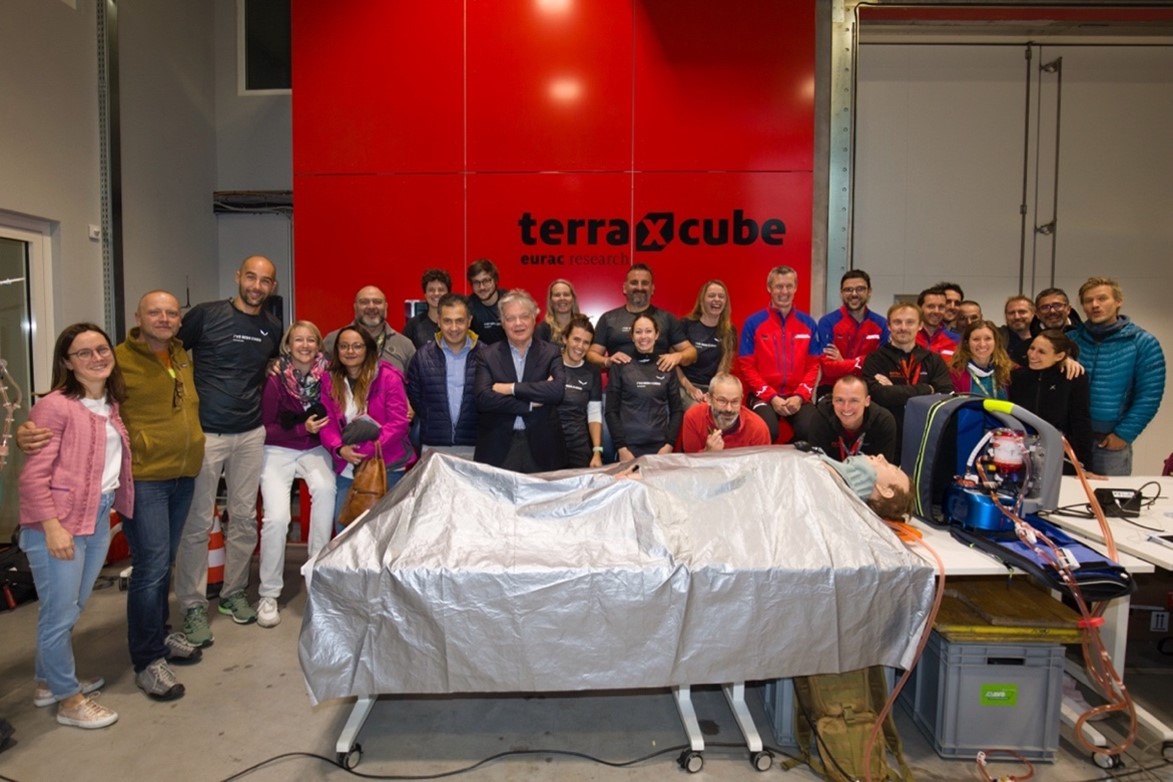Throughout residency I had heard only whispers. The terraXcube, a portal capable of transportation to extreme altitude, blizzards, high wind gusts, day or night. A mystical laboratory deep in the Dolomites. What is the terraXcube? Why is it so revered? Will I ever get to behold its greatness? Questions that kept me up at night.
And to my delight, early in my wilderness medicine fellowship, my program director, Dr. Martin Musi, invited me on a trip to experience the infamous cube for myself. As part of the 2023 International Commission on Alpine Rescue Conference (ICAR) in Italy, the renowned researchers at the Institute of Mountain Emergency Medicine held an unforgettable training day at terraXcube. On a beautiful morning in October, physicians and advanced providers from around the world convened at the NOI Techpark in Bolzano, Italy.
We began the day with breakfast and a healthy dose of caffeine, where members of the Institute of Mountain Emergency Medicine (a member of the larger Eurac research group), led by Dr. Giacomo Strapazzon and senior researcher Dr. Simon Rauch, emerged to welcome us and explain the plan for the day. We’d break into small groups and rotate through a number of stations exploring how Eurac research is working to bring cutting edge hospital therapies to the wilderness setting, participate in a research station aimed to test how extreme cold impacts our abilities to perform advanced procedures, and perhaps most excitingly, a high-fidelity wilderness rescue scenario in the large cube.

Medical personnel performing a rescue scenario in nighttime and freezing conditions. (Eurac Research/Andrea De Giovanni)
Before we embark on the journey of the day, some important background. In 2011, Dr. Hermann Brugger, a world authority on avalanche science, renowned researcher, and founder of the Institute of Mountain Emergency Medicine, began the process of creating a controlled chamber for wilderness research on an unprecedented scale. In 2019, the terraXcube opened its door to a myriad of research applications. The terraXcube is a facility consisting of three general sections: a large cube, small cube and mini cube. Everything I had heard about the large cube was true and more: over 360 cubic meters (12,700 cubic feet), able to lower the barometric pressure to a maximum altitude of 9,000 meters (29,528 feet- slightly higher than Mount Everest), able to reach -40°C (-40°F), and able to produce rain, snow, and wind gusts up to 108 KMH. The small cube is composed of four smaller rooms able to reach a peak altitude of 4,000 meters, (13,100 feet), -29°C (-20°F), and precipitation. The mini cube is a small room typically used for industry testing, able to achieve rapid temperature swings.
The first station of the day for our group involved ECMO training, or extracorporeal membrane oxygenation, a pinnacle of modern medicine that can essentially do the jobs of both the heart and/or lungs if needed. Eurac had collaborated with leading industry representatives to provide high quality mannequins and real ECMO circuits. I stood next to Martin as we cannulated a mannequin onto an ECMO circuit, passing unnervingly large dilators into femoral vessels. The room next door was the large cube, and as we cannulated, vivid screams and yelling filled our room. We knew the upcoming simulation would, indeed, be high fidelity. Our next station focused on REBOA, or resuscitative endovascular occlusion of the aorta, and the efforts and science behind this incredible technology and its potential for use in the prehospital setting.

Providers performing advance procedures in warm and cold temperatures. (Eurac Research/Andrea De Giovanni)
Next up was the scenario. I donned my cold layers and our team received the briefing on what lay ahead. It was nighttime in the alpine and a group of climbers were injured by an avalanche and stranded. We’d be the medical personnel, with Martin as our team lead, accompanied by South Tyrolean professional alpine rescuers. In the scenario, we’d be helicoptered into the rescue site. The chamber door opened and I was hit with a gust of freezing wind. It was pitch black and we turned on our head lamps. As we navigated through high gusts and sub-zero temperatures, screams filled the large room, and our headlights scanned the scene ahead for patients. I found my patient: gravely injured and tucked behind a large structure, nearly pinned against the wall. He was alert and protecting his airway however was also hypotensive with absent breath sounds on the left, an unstable pelvis, and impending hypothermia. For the next half hour, I worked on resuscitating my patient, with the intermittent help of our rescuers. In the end, he survived, after humeral IO placement, blood transfusions, binding of an unstable pelvis, and decompression of his tension pneumothorax all while keeping the patient warm and as shielded from the elements as possible. He fared better than other patients, including a patient in cardiac arrest that required significant resources including multiple members of the team and was airlifted out to the nearest ECMO center. After deciding as a team the priority order of evacuations, we signed out our respective patients to the nearby trauma centers and debriefed. Despite being technically inside, the simulation felt incredibly real and provided the discomforts of a nighttime high alpine rescue: it was cold, it was pitch-black, and it was very windy! All-in-all, high fidelity indeed.
To celebrate, we made our way down to the small cubes, where we rotated through a number of procedure stations, performing them in both typical room temperature and subzero conditions, including chest tube insertion, endotracheal intubation with video laryngoscopy, and cricothyrotomy.

Participants and researchers celebrating a great day at TerraXCube! (Eurac Research/Andrea De Giovanni)
By the end of the day, I had been thoroughly immersed in the terraXcube and it had surpassed all my expectations. The terraXcube is a tremendously unique, world-class facility with many potential applications. The incredible ability to precisely manipulate environmental conditions provides an unmatched opportunity to provide trainings and research applications for both cold and high altitude studies, without the risk and uncertainty of the field. The multiple different rooms of varying sizes additionally provided the opportunity to scale any project, from groups to individuals. Our groups convened for a final celebration of a successful day, only to be greeted by an unexpected gratuity bag with shirts that read: We got cubed! We certainly did.